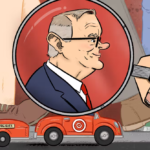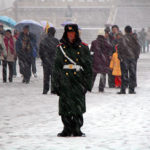Easter is messing with our heads
As chocolate-lovers around the country gear up for the Easter long weekend, Baptist Minister and World Vision Christian Commitments Co-ordinator, Anne Wilkinson-Hayes, explains the true meaning behind this religious tradition.
It appears that the autumn/spring equinox, chosen as the time to celebrate Easter, is having an identity crisis this year. Australia continues to see temperatures usually associated with mid-summer and much of northern Europe is blasted with blizzards normally reserved for December. For me, this aberration reinforces the deeper reality of the Easter story because, far from the world of cute bunnies and coloured eggs, Easter opens a cosmic flaw in our understandings of the universe: it messes with our heads.
We live and then we die – it’s a truth that few would argue with. Death ends our lives and is the ultimate destiny that none of us can avoid. We don’t talk about it very much anymore, and in western society death is a rather distant and sanitised process – we no longer have the bodies of loved ones on the dining room table and grief is increasingly privatised. Nonetheless, death is still the enemy of life. Disease, destruction and death still plague our world and cause misery to thousands each day regardless of our scientific progress. It is, apparently, the final word.
The resurrection at the heart of the Easter story poses a unique challenge to this final reality and it is why Easter is the culmination of the Christian calendar. Most will probably stop reading at this point – rational people do not believe that a person can rise from the dead – but stay with me; millions today and throughout history have found compelling truth in this possibility.
The heart of the Christian gospel is that God became human in Jesus and showed us how to live and love fully. The crucifixion was not a failure of this way, but rather a continuing demonstration that the way to overcome all that is wrong and distorted in the world is through love and sacrifice. And the resurrection that followed was God’s great ‘Yes!’ to this way of life and love.
Easter teaches us that the way to change the world is not through power or violence; it is not through wealth and manipulation, but through love and letting go of self and self-interest. Most of us know this deep inside, but find it hard to live out. The cross is the ultimate motif of letting go and the resurrection is the affirmation that this way of love changes the core fabric of the universe. Death is no longer the end. Evil can be redeemed. The resurrection allows hope to enter life – it is the crack that lets the light in.
For many, this possibility of life breaking the power of death is a deeply motivating force in the struggle for social change. It enables us to keep believing there can be an end to poverty; to trafficking; to discrimination and injustice. In the face of huge odds to the contrary, it means we can keep hoping that beauty can emerge from the ashes, and life, not death, is the final word.
So enjoy your hot cross buns and cream eggs as a celebration of the changing season, but don’t confuse them with Easter. The real message of Easter is so much bigger and deeper and its reality messes with our heads – and with our hearts.
Anne Wilkinson-Hayes is a Baptist minister; a mother; a lecturer; a church consultant; a vegetable–grower and currently seconded to World Vision Australia to find life-giving ways to deepen and express the Christian identity of the organisation.













